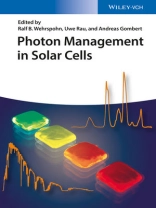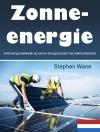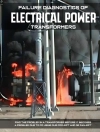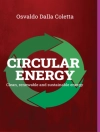Written by renowned experts in the field of photon management in solar cells, this one-stop reference gives an introduction to the physics of light management in solar cells, and discusses the different concepts and methods of applying photon management.
The authors cover the physics, principles, concepts, technologies, and methods used, explaining how to increase the efficiency of solar cells by splitting or modifying the solar spectrum before they absorb the sunlight. In so doing, they present novel concepts and materials allowing for the cheaper, more flexible manufacture of solar cells and systems.
For educational purposes, the authors have split the reasons for photon management into spatial and spectral light management.
Bridging the gap between the photonics and the photovoltaics communities, this is an invaluable reference for materials scientists, physicists in industry, experimental physicists, lecturers in physics, Ph.D. students in physics and material sciences, engineers in power technology, applied and surface physicists.
İçerik tablosu
Preface XIII
List of Contributors XV
1 Current Concepts for Optical Path Enhancement in Solar Cells 1
Alexander N. Sprafke and Ralf B. Wehrspohn
1.1 Introduction 1
1.2 Planar Antireflection Coatings 2
1.3 Optical Path Enhancement in the Ray Optical Limit 4
1.4 Scattering Structures for Optical Path Enhancement 5
1.5 Resonant Structures for Optical Path Enhancement 7
1.6 Ultra-Light Trapping 10
1.7 Energy-Selective Structures as Intermediate Reflectors for Optical Path Enhancement in Tandem Solar Cells 13
1.8 Comparison of the Concepts 16
1.9 Conclusion 17
References 17
2 The Principle of Detailed Balance and the Opto-Electronic Properties of Solar Cells 21
Uwe Rau and Thomas Kirchartz
2.1 Introduction 21
2.2 Opto-Electronic Reciprocity 21
2.2.1 The Principle of Detailed Balance 21
2.2.2 The Shockley–Queisser Limit 22
2.2.3 Derivation of the Reciprocity Theorem 24
2.3 Connection to Other Reciprocity Theorems 29
2.3.1 Emitter and Collector Currents in Transistors 29
2.3.2 Tellegens’s Network Theorem 30
2.3.3 Differential Reciprocity Relations by Wong and Green 31
2.3.4 Würfel’s Generalization of Kirchhoff’s Law 33
2.3.5 Reciprocity Relation for LED Quantum Efficiency 33
2.3.6 Shockley–Queisser Revisited 34
2.3.7 Influence of Light Trapping 35
2.4 Applications of the Opto-Electronic Reciprocity Theorem 37
2.4.1 Experimental Verifications 37
2.4.2 Spectrally Resolved Luminescence Analysis 39
2.4.3 Luminescence Imaging 40
2.5 Limitations to the Opto-Electronic Reciprocity Theorem 43
2.6 Conclusions 44
References 44
3 Rear Side Diffractive Gratings for Silicon Wafer Solar Cells 49
Marius Peters, Hubert Hauser, Benedikt Bläsi, Matthias Kroll, Christian Helgert, Stephan Fahr, Samuel Wiesendanger, Carston Rockstuhl, Thomas Kirchartz, Uwe Rau, Alexander Mellor, Lorenz Steidl, and Rudolf Zentel
3.1 Introduction 49
3.1.1 Gratings for Solar Cells – Basic Idea and Challenges 49
3.1.2 A Short Literature Review 50
3.2 Principle of Light Trapping with Gratings 52
3.3 Fundamental Limits of Light Trapping with Gratings 56
3.4 Simulation of Gratings in Solar Cells 58
3.4.1 Optical Simulation Using RCWA/FMM 58
3.4.2 Optical Simulation Using the Matrix Method 61
3.4.3 Electro-Optically Coupled Simulation Using RCWA and Sentaurus Device 65
3.5 Realization 67
3.5.1 Electron-Beam Lithography 68
3.5.2 Self-Organizing Photonic Crystals 72
3.5.3 Fabrication of Rear Side Gratings via Interference Lithography and Nanoimprint Lithography 75
3.6 Topographical Characterization 78
3.6.1 Atomic Force Microscopy 78
3.6.2 Scanning Electron Microscopy 80
3.6.3 Focused Ion Beam Milling 81
3.7 Summary 84
References 84
4 Randomly Textured Surfaces 91
Carsten Rockstuhl, Stephan Fahr, Falk Lederer, Karsten Bittkau, Thomas Beckers, Markus Ermes, and Reinhard Carius
4.1 Introduction 91
4.2 Methodology 93
4.2.1 Structure of a Referential Solar Cell and Description of Available Substrates 94
4.2.2 Rigorous Methods 96
4.2.3 Scalar Methods 97
4.2.4 Properties of Interest 98
4.2.5 Near-Field Scanning Optical Microscopy 99
4.3 Properties of an Isolated Interface 100
4.3.1 Near-Field Properties 100
4.3.2 Far-Field Properties 102
4.4 Single-Junction Solar Cell 104
4.4.1 Absorption Enhancement 104
4.4.2 Design of Optimized Randomly Textured Interfaces 106
4.5 Intermediate Layer in Tandem Solar Cells 110
4.6 Conclusions 112
Acknowledgments 113
References 113
5 Black Silicon Photovoltaics 117
Kevin Füchsel, Matthias Kroll, Martin Otto, Martin Steglich, Astrid Bingel, Thomas Käsebier, Ralf B.Wehrspohn, Ernst-Bernhard Kley, Thomas Pertsch, and Andreas Tünnermann
5.1 Introduction 117
5.1.1 Fabrication Methods 117
5.1.2 Reactive Ion Etching 119
5.1.3 Laser Processing 122
5.1.4 Chemical and Electrochemical Etching 124
5.2 Optical Properties and Light Trapping Possibilities 126
5.2.1 Overview 126
5.2.2 ICP-RIE Black Silicon 128
5.2.3 Influence of Dielectric Coatings 130
5.2.4 Influence of the Substrate Thickness and Limiting Efficiency 132
5.3 Surface Passivation of Black Silicon 135
5.3.1 Requirements for Black Silicon Passivation 136
5.3.2 Possible Passivation Schemes 136
5.3.3 Passivation of Black Silicon Surfaces 139
5.3.3.1 Surface Damage and Sample Cleaning 139
5.3.3.2 Effective Passivation of ICP-RIE Black Silicon 140
5.4 Black Silicon Solar Cells 142
References 144
6 Concentrator Optics for Photovoltaic Systems 153
Andreas Gombert, Juan C.Mi˜nano, Pablo Benitez, and Thorsten Hornung
6.1 Fundamentals of Solar Concentration 153
6.1.1 Introduction 153
6.1.2 Concentration and Acceptance Angle 153
6.1.3 Optical Efficiency 157
6.1.4 Effect of Spatial and Spectral Non-uniformities on the Cell Illumination 158
6.2 Optical Designs 159
6.2.1 Classical Imaging Concentrators 160
6.2.2 Nonimaging Secondary Optics 161
6.2.3 Advanced Concentrator Designs 162
6.2.4 Freeform SMS Concentrators 163
6.2.5 Multifold Köhler Concentrators 164
6.2.6 Comparison 166
6.3 Silicone on Glass Fresnel Lenses 169
6.3.1 Physical Influence of Lens Temperature 170
6.3.2 Influence of Lens Temperature on Efficiency 172
6.4 Considerations on Concentrators in HCPV Systems 175
6.4.1 General Requirements on CPV Concentrator Optics 175
6.4.2 Design Considerations 176
6.4.3 Experiences with Concentrator Designs 178
6.5 Conclusions 179
References 179
7 Light-Trapping in Solar Cells by Directionally Selective Filters 183
Carolin Ulbrich, Marius Peters, Stephan Fahr, Johannes Üpping, Thomas Kirchartz, Carsten Rockstuhl, Jan Christoph Goldschmidt, Andreas Gerber, Falk Lederer, Ralf Wehrspohn, Benedikt Bläsi, and Uwe Rau
7.1 Introduction 183
7.2 Theory 185
7.2.1 Radiative Efficiency Limit 185
7.2.2 Ultra-Light-Trapping 187
7.2.2.1 Universal Light-Trapping Limit for Completely Randomized Light 187
7.2.3 Annual Yield for Directionally Selective Solar Absorbers 190
7.3 Filter Systems 192
7.3.1 1D Layer Stack Rugate Filters 192
7.3.2 3D Photonic Crystal Opal Structures 193
7.4 Experimental Realization 197
7.4.1 Bragg Filter Covering a Hydrogenated Amorphous Silicon Solar Cell 197
7.4.2 Bragg Filter Covering a Germanium Solar Cell 201
7.5 Summary and Outlook 202
References 203
8 Linear Optics of Plasmonic Concepts to Enhance Solar Cell Performance 209
Gero von Plessen, Deepu Kumar, Florian Hallermann, Dmitry N. Chigrin, and Alexander N. Sprafke
8.1 Introduction 209
8.2 Metal Nanoparticles 210
8.2.1 Optical Excitations in Metal Nanoparticles 210
8.2.2 Control of Optical Properties 212
8.2.2.1 Resonance Energies of Particle Plasmons 213
8.2.2.2 Linewidths of Particle-Plasmon Resonances 215
8.2.2.3 Peak Heights of Particle-Plasmon Resonances 216
8.2.2.4 Scattering Quantum Efficiencies 216
8.2.2.5 Light-Scattering Patterns 217
8.2.2.6 Near-Field Effects 217
8.2.2.7 Combinations of Effects 218
8.3 Surface-Plasmon Polaritons 218
8.4 Front-Side Plasmonic Nanostructures 219
8.5 Rear-Side Plasmonic Nanostructures 221
8.6 Further Concepts 222
8.7 Summary 226
Acknowledgments 226
References 227
9 Up-conversion Materials for Enhanced Efficiency of Solar Cells 231
Jan Christoph Goldschmidt, Stefan Fischer, Heiko Steinkemper, Barbara Herter, Sebastian Wolf, Florian Hallermann, Gero von Plessen, Jacqueline Anne Johnson, Bernd Ahrens, Paul-Tiberiu Miclea, and Stefan Schweizer
9.1 Introduction 231
9.2 Up-Conversion in Er3+-Doped ZBLAN Glasses 232
9.2.1 Samples 232
9.2.2 Optical Absorption 233
9.2.3 Up-Conversion 234
9.3 Up-Conversion in Er3+-Doped β-Na YF4 237
9.3.1 Device Measurements 239
9.4 Simulating Up-Conversion with a Rate Equation Model 240
9.5 Increasing Up-Conversion Efficiencies 242
9.5.1 The Up-Converter Material 242
9.5.1.1 Phonon Energy 242
9.5.1.2 Doping Concentration 243
9.5.2 The Environment around the Up-Converter 245
9.5.2.1 Plasmon Enhanced Up-Conversion 245
9.5.2.2 Modeling Dielectric Nanostructures 246
9.5.3 Spectral Concentration 248
9.6 Conclusion 251
Acknowledgments 252
References 252
10 Down-Conversion in Rare-Earth Doped Glasses and Glass Ceramics 255
Stefan Schweizer, Christian Paßlick, Franziska Steudel, Bernd Ahrens, Paul-Tiberiu Miclea, Jacqueline Anne Johnson, Katharina Baumgartner, and Reinhard Carius
10.1 Introduction 255
10.2 Physical Background 257
10.2.1 Rare-Earth Ions 257
10.2.2 Glass Systems 258
10.2.2.1 Phonons 259
10.2.2.2 ZBLAN Glasses 259
10.2.2.3 Borate Glasses 260
10.3 Down-Conversion in ZBLAN Glasses and Glass Ceramics 260
10.3.1 Samples 261
10.3.2 Glass-Ceramic Cover Glasses for High Efficiency Solar Cells 261
10.3.2.1 Absorption 262
10.3.2.2 Short-Circuit Current 264
10.3.2.3 Internal Conversion Efficiency 265
10.3.2.4 Quantum Efficiency Increase 266
10.3.3 Influence of Multivalent Europium-Doping 267
10.3.3.1 X-Ray Absorption near Edge Structure 268
10.3.3.2 X-Ray Diffraction 270
10.3.3.3 Photoluminescence 272
10.3.4 Conclusion 274
10.4 Down-Conversion in Sm-Doped Borate Glasses for High-Efficiency Cd Te Solar Cells 275
10.4.1 Samples 275
10.4.2 External Quantum Efficiency of Cd Te Solar Cells 276
10.4.3 Optical Absorption and Fluorescence Emission 276
10.4.4 Efficiency Increase 277
10.4.5 Conclusion 279
10.5 Summary 280
Acknowledgment 281
References 281
11 Fluorescent Concentrators for Photovoltaic Applications 283
Jan Christoph Goldschmidt, Liv Prönneke, Andreas Büchtemann, Johannes Gutmann, Lorenz Steidl, Marcel Dyrba, Marie-Christin Wiegand, Bernd Ahrens, Armin Wedel, Stefan Schweizer, Benedikt Bläsi, Rudolf Zentel, and Uwe Rau
11.1 Introduction 283
11.2 The Theoretical Description of Fluorescent Concentrators 285
11.2.1 Detailed Balance Considerations 285
11.2.2 Photonic Structures to Increase Fluorescent Collector Efficiency 286
11.2.3 Possible System Configurations – Side-Mounted and Bottom-Mounted Solar Cells 287
11.2.3.1 Thermodynamic Efficiency Limits of Fluorescent Concentrators 290
11.2.3.2 Non-perfect Photonic Structure 292
11.2.3.3 Luminescent Materials in Photonic Structures 293
11.3 Materials for Fluorescent Concentrators 296
11.3.1 Systems Based on Organic Matrix Materials 296
11.3.1.1 The Matrix Material 296
11.3.1.2 The Luminescent Species 299
11.3.2 Completely Inorganic Systems Based on Rare Earths 304
11.4 Experimentally Realized Fluorescent Concentrator Systems 307
11.4.1 Systems with Side-Mounted Solar Cells 307
11.4.2 Systems with Bottom-Mounted Monocrystalline Silicon Solar Module 308
11.4.3 Increasing Efficiency with Photonic Structures 310
11.4.3.1 Systems with Side-Mounted III–V Solar Cell 310
11.4.3.2 Systems with Bottom-Mounted Amorphous Silicon Solar Cell 312
11.5 Conclusion 314
Acknowledgments 314
References 315
12 Light Management in Solar Modules 323
Gerhard Seifert, Isolde Schwedler, Jens Schneider, and Ralf B.Wehrspohn
12.1 Introduction 323
12.2 Fundamentals of Light Management in Solar Modules 324
12.2.1 Basic Physical Concepts of Light Management in Solar Modules 324
12.2.1.1 Optical Losses due to Reflection and Absorption 324
12.2.1.2 Optical Description of Textured Interfaces or Surfaces 326
12.2.1.3 Spectral Effects and Solar Concentration 329
12.2.1.4 Effects of Incidence Angle Variation and Diffuse Light 331
12.2.2 Assessment of the Optical Performance of Solar Modules 331
12.2.2.1 Experimental Techniques 331
12.2.2.2 Simulation Approaches and Studies 333
12.3 Technological Solutions for Minimized Optical Losses in Solar Modules 334
12.3.1 Minimization of Optical Losses in Front Glass Sheets 334
12.3.2 Anti-reflection (AR) Technologies for PV Module Front Surface 336
12.3.2.1 Nano-scale Technologies for Anti-reflective Treatment of PV Front Glass 336
12.3.2.2 Micro-scale Structures for Light-Trapping on PV Front Glasses 338
12.3.3 Material Selection and Optimization for Encapsulation Film 338
12.3.4 Minimization of Losses due to Metallization and Contact Tabs 340
12.3.5 Optical Optimization of Cell Front and Back Interface 342
12.3.6 Redirection of Light from Cell Interspaces 343
12.4 Outlook 343
References 344
Index 347
Yazar hakkında
Ralf B. Wehrspohn studied physics at the University of Oldenburg, Germany, and received his Ph D degree from the Ecole Polytechnique in Paris in 1997. Until 1999 he worked on thin-fi lm transistors for AMLCDs at Philips Research. From 1999 until 2003 he led the Porous Materials/Photonic Crystals group at the Max Planck Institute of Microstructure Physics in Halle, after which he held a chair at the Physics department of the University of Paderborn for three years. Since 2006, he has been the director of the Fraunhofer-Institute for Mechanics of Materials and a Professor of Physics at the Martin-Luther-University Halle-Wittenberg. Professor Wehrspohn was awarded the Maier-Leibnitz Prize of the German Science Foundation in 2003.
Uwe Rau studied physics at the University of Tübingen, Germany, and at the University Claude Bernard, Lyon, France. He obtained his Ph D 1991 from the Physical Institute of the University Tübingen. From 1991-1993 he worked at the Max Planck Institute for Solid-State Research. He was scientifi c group leader from 1993-2007 at the University Bayreuth and at the University Stuttgart. Since 2007 he is full professor at RWTH Aachen (Faculty Electrical Engineering and Information Technology, Chair of Photovoltaics). Simultaneously he is director of the Institute of Energy and Climate Research IEK5-Photovoltaics at Forschungszentrum Jülich).
Andreas Gombert studied photo engineering and optics in Cologne, Germany, and Strasbourg, France, and received his Ph D from the University Louis Pasteur, Strasbourg. His professional career started in 1986 at the Fraunhofer Institute for Physical Measurement Techniques in the fi eld of integrated optics. From 1991to 2008, he worked at the Fraunhofer Institute for Solar Energy Systems where headed the department Materials Research and Applied Optics. Since 2008 he is Vice President System Platform and R&D and since 2014 also Managing Director of Soitec Solar Gmb H, Freiburg, Germany, a division of the Soitec Group. He lectures at Technical Faculty of the University of Freiburg, Germany where he also habilitated.












